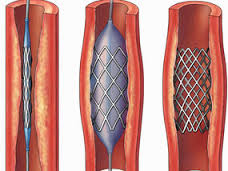
Coronary angioplasty and stents
Is a procedure that helps helps improve the blood supply to heart muscle by widening narrowed coronary arteries and inserting a small tube called a stent.
A stent is a small mesh tube that’s used to act like a scaffold to help keep artery open .Stents usually made of metal mesh or fabric. Some stents are coated with medicine that is slowly and continuously released into the artery.
people who placed a stent need to take certain medications to help reduce the risk of blood clots forming around the stent. These include:
-Aspirin, taken every morning for life
-Clopidogrel, taken for one to 12 months
-Prasugrel or ticagrelor, as alternatives to clopidogrel in some hospitals
Once the stent is in place, it becomes incorporated into the vessel wall and covered with endothelial tissue fairly quickly.
Dental point of view
We all have bacteria in our mouths, daily routines like chewing, brushing ,flossing even normal injuris—can allow bacteria to enter the bloodstream . A healthy immune system prevents these bacteria from causing any harm. however, for some people can cause an infection elsewhere in the body.
Who is at risk?
At times physicians and dentists recommend that a patient take antibiotics before certain dental procedures. This is called “antibiotic prophylaxis.” Antibiotic prophylaxis is recommended for a small number of people who have specific heart conditions..
The American Heart Association Antibiotic prophylaxis guidelines:
– Artificial heart valves.
-A history of an infection of the lining of the heart or heart valves( infective endocarditis).
-A heart transplant in which a problem develops with one of the valves inside the heart.
-Heart conditions that are present from birth, such as:
i. Unrepaired cyanotic congenital heart disease, including people with palliative shunts and conduit.
ii.Defects repaired with a prosthetic material or device—whether placed by surgery or catheter intervention—during the first six months after repair.
iii.Cases in which a heart defect has been repaired, but a residual defect remains at the site or adjacent to the site of the prosthetic patch or prosthetic device used for the repair.
The guidelines are re-evaluated every few years to make sure that they are based on the best scientific evidence. These reviews have uncovered no evidence that taking antibiotics before dental treatment prevents infections of the heart or orthopedic implants. Therefore, for most people, the known risks of taking antibiotics may outweigh the uncertain benefits. Risks related to antibiotic use include upset stomach and allergic reactions, including anaphylactic shock (a severe allergic reaction that can be life threatening) and diarrhea and other intestinal problems.
Bottom line
For Coronary angioplasty and stents No antibiotic prophylaxis is recommended .
Leave a reply →
Leave a reply